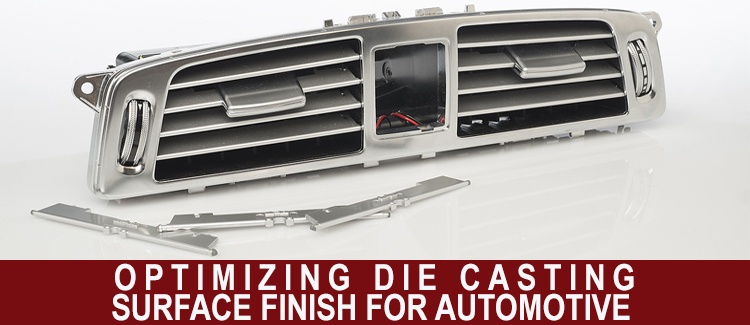As winner of numerous international awards, Bruschi Spa is known for its innovative approach in design and technology. We are glad to share our insights and experiences with the industry members.
Optimizing die casting surface finish for automotive
The automotive industry has requirements that are both functional and aesthetic when designing a component which should be produced by using die casting process. The main aspect a die caster will seek to ensure is oxidation prevention, therefore requirement on component is to extend resistance to atmospheric agents.
It is furthermore important to emphasize that zinc does not generate red but white oxidation, called salification. Salification process is analyzed when product is exposed to an accelerated oxidation process by undergoing the worst conditions to provoke results. For these specific reasons, automotive industry commonly requires a number of SSL resistance which is then certified by results of tests.
These requirements however change based on component’s position inside vehicle: if the product is placed internally it will only require functional treatment, if visibly positioned, it will also require aesthetical treatment.
In order to obtain these goals, functional and aesthetic, various types of die casting surface finish are available.
In the following article we will focus on:
- Chromating
- Tech-seal
- Black zinc
Chromating
By chromating we refer to a conversion coating to avoid oxidation: this is not a galvanic process but a transformation of the product surface by exposure to specific products. Through this type of finishing a protective layer is formed which, in contact with air, increases resistance to oxidation and protects materials from white corrosion.
This type of finishing may be applied as a final step in the production cycle or a prior step to other finishing steps. Below is a concrete example of chromating in the automotive industry where this finishing is applied as an intermediate step.
Case study: louvers on air vents
In the production of components such as car air vents louvers, chromating treatment precedes painting process.
Beyond aesthetical aspect guaranteed by painting process, as it is a visible element, component needs to be resistant to oxidation and to a range of temperatures, ranging from cold in summer and hot in winter.
The chromation, in this case, ensures a double scope: both functional, to avoid oxidizing, and aesthetical, as it prepares the surface for painting process, improving performance.
In aesthetical terms it is important to emphasize that the glossiness or glazed of the final product depends on the state of product surface before chromating, hence, if a glossy surface is required by client, a vibrating treatment will be needed before chromating.
Tech-seal
When a product needs to be particularly resistant to abrasion and surface defect in general such as scratches, the tech-seal treatment is applied.
Tech-seal is an organic water based treatment that allows to improve resistance to corrosion by means of the barrier effect, coloring the product in available colors and, at the same time, adding the correct friction coefficient. It is a water or solvent based organic sealing with a thickness of approximately 5 µm per layer, increasing the resistance to corrosion in saline mist to over 1.000 hours.
For example, for a part needing insertion into the mechanism which controls opening of sun roof, tech-seal treatment will improve not only resistance to impact but also improve sliding movement by generating less friction.
Black Zinc
Black Zinc is a protective and decorative process that provides a glossy and homogeneous black finish on the product.
The product often does not just need to be resistant but needs to have aesthetic qualities and match the color of other components it will be assembled with.
This happens, for example, with products needing to be assembled with black plastic components, hence requiring a black zinc treatment.
The process, beyond providing SSL resistance, ensures aesthetical aspect of part and can be completed with an oil sealing treatment which uniforms the color and increases level of resistance to both impact and scratching.
Finishing is performed on a frame, with the part hanging on hooks and immersed to obtain a uniform color and avoid iridescence.
In this article, we only discussed just a selection of a lager variety of die casting surface finish treatments. Each one of these treatments has different impact not only on the aesthetic and functional aspects of final element, but also on production costs. As some treatments include extra machining or additional materials, they have higher cost than others.
An experienced Die Caster is able to choose the most appropriate treatment in order to meet clients’ requirements without increasing production costs more than necessary.
To be updated on trends and innovations in Zinc Die Casting Industry, you are welcome to subscribe to our blog.


